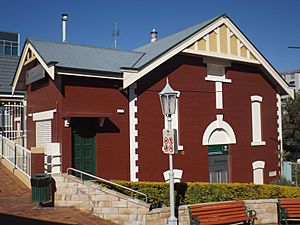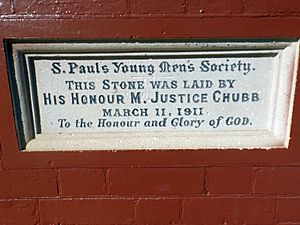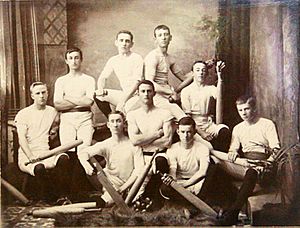St Paul's Young Men's Club, Ipswich facts for kids
Quick facts for kids St Paul's Young Men's Club, Ipswich |
|
|---|---|

The building as it looked in 2016
|
|
| Location | 48 d'Arcy Doyle Place (formerly Nicholas Street), Ipswich, City of Ipswich, Queensland, Australia |
| Design period | 1900–1914 (early 20th century) |
| Built | 1911 |
| Architect | George Brockwell Gill |
| Official name: St Paul's Young Men's Club – Art Gallery, Ipswich Regional Art Gallery, St Paul's Young Men's Society Hall | |
| Type | state heritage (built) |
| Designated | 21 October 1992 |
| Reference no. | 600584 |
| Significant period | 1911 (fabric) 1911–1939, 1939–1975 (historical) |
| Lua error in Module:Location_map at line 420: attempt to index field 'wikibase' (a nil value). | |
The St Paul's Young Men's Club is a historic building in Ipswich, Australia. It was built in 1911 to be a clubhouse but is now an art gallery. Because of its history, it is listed on the Queensland Heritage Register. The building was designed by a well-known architect named George Brockwell Gill. Today, it is also known as the Ipswich Regional Art Gallery.
Contents
History of the Building
The St Paul's Young Men's Club is a two-story brick building. It was first built as a meeting place for a church group called St Paul's Young Men's Society.
A Club for Young Men
The idea for the building started in 1907. The group needed to raise money to build it. Lady Chelmsford, the wife of the Governor of Queensland, even visited Ipswich to help start the fundraising. The architect, George Brockwell Gill, drew up the plans in 1908. However, the first price to build it was too high.
After more fundraising, the building work finally began. The foundation stone was laid on March 11, 1911. The building officially opened in December 1911.
The club's goal was to help young men grow in mind, body, and spirit. The building had a reading room, a gym, a bathroom, and a billiard room. It even had a piano. The club offered many activities, like sports, public speaking, and fun debates that were like a pretend parliament.
Helping Soldiers and the City
During World War I, the club offered its hall to be used as a "Soldiers' Rest Room." A group of local women helped furnish the hall and run the rest room for soldiers.
In 1938, the Ipswich City Council decided to buy the building. The council needed more office space, and this building was part of the solution. In 1939, the council's engineering staff moved in.
Later, in 1975, the building became the city library. Around this time, the outside brick was painted cream to match a new building across the street. In the 1980s, the library moved to a new location. The building was then renovated to become the Ipswich Regional Art Gallery.
What the Building Looks Like
The former St Paul's Hall is a simple, two-story brick building. It was built on a steep slope, so the main entrance on the north side leads to the upper floor.
Outside Features
The building has a simple style from a time known as the Federation period. It has a roof made of corrugated galvanised iron and timber details in the gables (the triangular parts of the roof). The windows are made of timber with many small panes of glass.
The windows on the front of the building are rectangular. On the side, the windows are arched. Some of these side windows are now filled with glass bricks, which let in light but are not clear.
Inside the Hall
The most impressive part of the interior is the upper floor. It has a high ceiling with exposed wooden beams called queen-post trusses. The ceiling itself is lined with wooden boards, which gives the space a warm, historic feel.
Why Is This Building Important?
The former St Paul's Young Men's Club was added to the Queensland Heritage Register in 1992. This means it is a special place that is protected for its historical and cultural value. Here are some of the reasons why it's important:
- It shows Queensland's history: The hall is a great example of a building made just for a church club in the early 1900s.
- It has a special look: People in the community value the building's simple but attractive design. It fits in well with other important civic buildings nearby.
- It has a connection to the community: The building was used as a rest stop for soldiers during World War I. It has also served the city as a library and now as an art gallery.
- It is a good example of an architect's work: The building shows the skill of architect George Brockwell Gill, who designed a useful community building with a limited budget.




